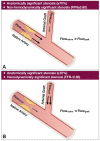Patient-specific computational simulation of coronary artery bypass grafting
- PMID: 36867601
- PMCID: PMC9983828
- DOI: 10.1371/journal.pone.0281423
Patient-specific computational simulation of coronary artery bypass grafting
Erratum in
-
Correction: Patient-specific computational simulation of coronary artery bypass grafting.PLoS One. 2025 Jan 29;20(1):e0318664. doi: 10.1371/journal.pone.0318664. eCollection 2025. PLoS One. 2025. PMID: 39879179 Free PMC article.
Abstract
Introduction: Coronary artery bypass graft surgery (CABG) is an intervention in patients with extensive obstructive coronary artery disease diagnosed with invasive coronary angiography. Here we present and test a novel application of non-invasive computational assessment of coronary hemodynamics before and after bypass grafting.
Methods and results: We tested the computational CABG platform in n = 2 post-CABG patients. The computationally calculated fractional flow reserve showed high agreement with the angiography-based fractional flow reserve. Furthermore, we performed multiscale computational fluid dynamics simulations of pre- and post-CABG under simulated resting and hyperemic conditions in n = 2 patient-specific anatomies 3D reconstructed from coronary computed tomography angiography. We computationally created different degrees of stenosis in the left anterior descending artery, and we showed that increasing severity of native artery stenosis resulted in augmented flow through the graft and improvement of resting and hyperemic flow in the distal part of the grafted native artery.
Conclusions: We presented a comprehensive patient-specific computational platform that can simulate the hemodynamic conditions before and after CABG and faithfully reproduce the hemodynamic effects of bypass grafting on the native coronary artery flow. Further clinical studies are warranted to validate this preliminary data.
Copyright: © 2023 Wu et al. This is an open access article distributed under the terms of the Creative Commons Attribution License, which permits unrestricted use, distribution, and reproduction in any medium, provided the original author and source are credited.
Conflict of interest statement
Yiannis S. Chatzizisis: Speaker honoraria, advisory board fees and research grant from Boston Scientific Inc., Advisory board fees and research grant from Medtronic Inc., U.S. patent (No. 21072P) for the invention entitled “Patient-specific computational planning of coronary artery bypass grafting”, Co-founder of ComKardia Inc. All other authors have no relevant conflict of interests to disclose. This does not alter our adherence to PLOS ONE policies on sharing data and materials.
Figures








References
-
- Lawton JS, Tamis-Holland JE, Bangalore S, Bates ER, Beckie TM, Bischoff JM, et al.. 2021 ACC/AHA/SCAI Guideline for Coronary Artery Revascularization: Executive Summary: A Report of the American College of Cardiology/American Heart Association Joint Committee on Clinical Practice Guidelines. Journal of the American College of Cardiology. 2022;79(2):197–215. Epub 2021/12/14. 10.1016/j.jacc.2021.09.005 . - DOI - PubMed
-
- Kawamura M, Nakajima H, Kobayashi J, Funatsu T, Otsuka Y, Yagihara T, et al.. Patency rate of the internal thoracic artery to the left anterior descending artery bypass is reduced by competitive flow from the concomitant saphenous vein graft in the left coronary artery. European journal of cardio-thoracic surgery: official journal of the European Association for Cardio-thoracic Surgery. 2008;34(4):833–8. doi: 10.1016/j.ejcts.2008.07.011 - DOI - PubMed
Publication types
MeSH terms
Grants and funding
LinkOut - more resources
Full Text Sources

